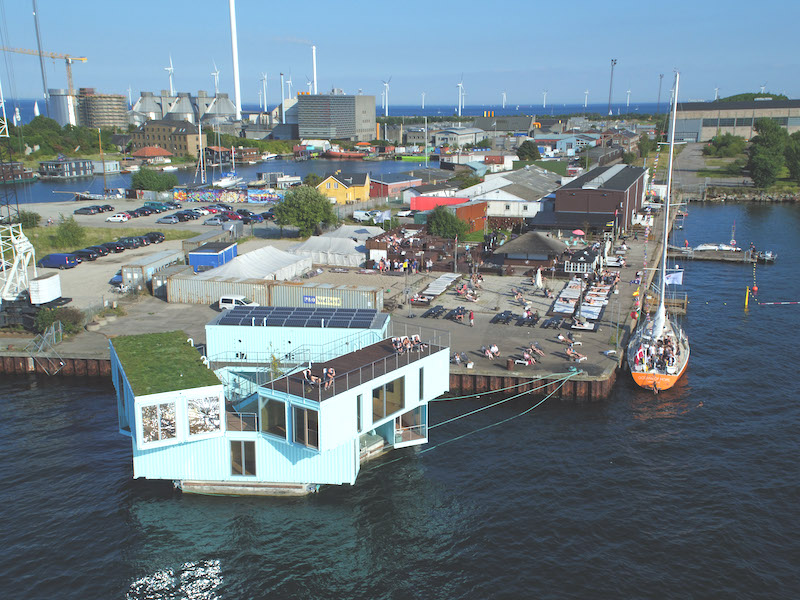Urban Rigger
January 7, 2017
With an important increase in the number of higher education student applicants in Denmark in recent years and a shortage of comfortable, conveniently located and reasonably priced student accommodation, Copenhagen housing start-up Urban Rigger came up with an ingenious idea in 2013 of how to meet the demands of this growing student body on a shoestring budget. They sought to build revolutionary low-cost modular dorms using shipping containers that can float in urban harbours and get Copenhagen’s own star architect, Bjarke Ingels, to design them.

It was the brainchild of Kim Loudrup, founder and CEO of Urban Rigger, who discovered it was a nightmare to find accommodation for his son who was going to university in Copenhagen, one of the 10 costliest cities in the world in which to live. A phenomenon witnessed internationally, there will be a total projected deficit in Europe of more than 4 million student beds by 2025.
In Denmark alone, it is estimated that 24,000 students are without residence. This lack of housing could have serious consequences for cities, as students find it challenging to attend schools in urban areas where they could participate in knowledge-based economies.
Recognising that Copenhagen’s centrally located harbour remains underutilised and underdeveloped, Urban Rigger—in which Bjarke Ingels Group (BIG) owns a 10-percent stake—introduced a new building typology. Optimised for harbour cities offering a practical, geographically independent and unconventional architectural solution, it would allow students to live in floating homes right in the city centre. The patented private initiative hopes to alleviate the desperate housing situation of many students in Europe.
Rather than trying to find available centrally located land to build on, it takes advantage of the potential of thousands of kilometres of untapped harbours, rivers and canals in Europe. The crowded city can thus expand without taking up valuable real estate.
Ingels recalls, “My former downstairs neighbour told me he had a friend that I had to meet. He turned out to be a maverick entrepreneur, who now wanted to help thousands of students migrating to big cities every year with no way to find a decent place to live. The idea itself was simple. Most major cities are port cities. The ports are turning from industry to living and working. Water is, in principle, free. The regulations on water are faster and simpler than on land.”

At the same time, the proposed lodgings are sustainable by relying on the existing shipping container industry. As the standardised container system permits goods to be transported globally and cheaply, it may be used to create ultra-flexible mobile dorms with modern amenities.
This upcycling of containers conserves materials and energy. Able to be organised into any number of smart, modular spatial configurations, the containers are also extremely durable, being made entirely of Corten steel.
“It’s harnessing the efficiencies of the container industry, which is a highly efficient, highly developed industry,” says Ingels. “We thought that maybe this could be an intelligent way to relieve stressful housing situations in a way that’s not just putting up tents, but creating completely safe, secure and high-standard living spaces. In the past, according to traditional urban planning, the waterfront was a logistical space, whereas now it can be turned into an enjoyable area. Many colleges and universities around the world are located by the water, and to give these students the opportunity to live in this low-cost, highly enjoyable space would be amazing.”
Like a houseboat, the student housing is buoyant. Ingels states, “In terms of sea-level rise, this is the most resilient form of housing because it moves with the water. It’s the only building type that will never flood.”
By designing a system of concrete pontoons and stacking nine containers in a circle, 12 studio residences are formed around a central, protective glass-shell-covered courtyard, used as a lively meeting place for students. It may be easily replicable in other harbour cities experiencing industrial decline and are in search of affordable accommodation where space is limited. Considered messy and dirty, these ports can thus be revitalised and converted into desirable residential areas.
Ingels explains, “Most major post-industrial cities in the world are experiencing some sort of a transformation and decline of their port industries. You’re seeing cities all over the world where you have increasingly available port areas that can be transformed and could be the home for alternate forms of urbanisation. To further that condition, we are seeing the shipping and container industry in Western Europe giving way to more economically competitive shipyards and manufacturing plants in Asia. You have a declining industry that makes and moves containers. In a way, Urban Rigger is a means to keep an endangered industry alive for another purpose. What we’re suggesting is to inject new life into it.”
The first in a potential fleet of floating dorms was recently completed in Copenhagen’s harbour with a rental of US$600 per month for a private bedroom, bathroom, kitchen and shared living areas. A prototype at the moment, students will settle in later this year once it moves to its permanent location.

To make affordable, highly efficient units, established environmentally friendly technologies were incorporated. Photovoltaic cells on the roof supply power, a NASA-developed aerogel insulates the interiors and energy-saving pumps are used for waste water, heating, cooling, circulation and drinking water. Hydro source heating converts the surrounding seawater into a free, efficient and clean natural heat source while reducing emissions by 81 percent, compared to conventional heating using natural gas, grid or oil as a power source. The heat transfer rate from water is higher than using the ground as a heat source.
The container homes are assembled in a shipyard in Poland, which can produce 100 units per year at US$700 to US$800 per square feet, and arrive via water at their final destination. “In terms of the architecture of Urban Rigger, a sort of new process was introduced,” notes Ingels.
“With big buildings, it’s always a prototype, and it’s always the first and the last one you’re going to do. You can take everything you learn from that experience to the next time you’re doing a project, but it will always be a new project in a new situation for a new client with a new programme. In this case, we’re going more into the realm of manufacturing. With the first iPhone, Apple learned a lot, and with the next generation and the next generation, it keeps becoming a more awesome product. That’s something we can never do with architecture, but we can do with Urban Rigger. The first Urban Rigger that arrived is a proof of concept. Based on the experience with this one, we’re going to make a 1.1, a 1.2 and eventually, a 2.0.”
PROJECT DATA
| Project Name | Urban Rigger |
|---|---|
| Location | Copenhagen, Denmark |
| Completion Date | September 2016 |
| Gross Floor Area | 680 square metres |
| Number of Rooms | 711 |
| Client/Owner | Udvikling Danmark A/S |
| Architecture Firms | Bjarke Ingels Group (BIG) |
| Principal Architect | Bjarke Ingels |
| Main Contractor | House on Water Ltd |
| Mechanical & Electrical Engineer | BIG |
| Civil & Structural Engineer | BIG |
| Images/Photos | BIG; Laurent de Carniere |
To read the complete article, get your hardcopy at our online shop/newsstands/major bookstores; subscribe to FuturArc or download the FuturArc App to read the issues.

